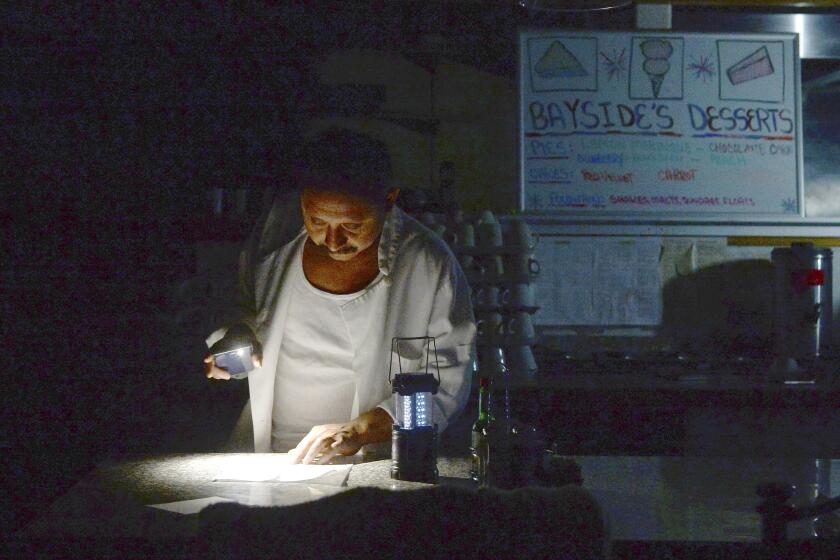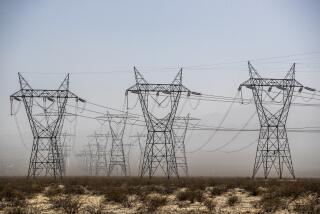California’s huge, humiliating power outages expose the vulnerabilities of PG&E’s power grid

California has always prided itself on being a high-tech pioneer. One exception? Power distribution.
With Pacific Gas & Electric Co. expected to cut electricity to 800,000 customers this week, the state is confronting its reliance on a transmission network that predates climate change, solar panels and lithium-ion batteries, depending instead on electric lines strung over thousands of miles on vulnerable wooden poles.
Until that changes, experts say, utility executives are sure to cut electrical service to large sections of the state during high winds, rather than risk downed lines and transformers like those that have sparked deadly wildfires over the last two years.
PHOTOS: Northern California deals with unprecedented power outages
Utility operators historically built power grids — with massive electrical plants fired by fossil fuels and transmission lines that stretched for hundreds of miles — to provide the cheapest possible electricity. They weren’t concerned about air pollution and global warming, or the more immediate threat from wildfires, said Michael Wara, director of Stanford University’s climate and energy policy program.
“Society has been delivering electricity the same way for 130 years — exposed lines on wood poles over dry grass,” said David Rabbitt, a county supervisor in Sonoma County, one of the areas hit by the massive blackout. “I think we know more now, certainly, and it’s time to actually move on with making the investments going forward.”
Will the current outages be a pivotal moment in transforming California’s power grid? If so, the transition will likely include Californians generating power closer to their homes via solar panels and wind generators. It will also include communities building microgrids, distinct power systems that can operate independent of massive utilities like PG&E, a behemoth that serves 16 million people spread across 70,000 square miles of Central and Northern California.
Millions of Californians could spend days without power as the state’s largest utility continues shutting off electricity in a desperate attempt to avoid wildfires sparked by windblown power lines.
In the meantime, utilities will continue to practice what is known as “de-energization,” otherwise known as blacking out customers.
The California Public Utilities Commission issued a resolution in July 2018 supporting the use of this “last resort” tactic to mitigate the risk of wildfires. PG&E last year set out its list of criteria for the so-called public safety power shutoffs. Among the potential triggers: a National Weather Service’s declaration of a red-flag fire warning, humidity levels of below 20% percent, wind forecasts of 25 miles an hour, or gusts of 45 miles an hour.
PG&E cited “gusty winds and dry conditions combined with a heightened fire risk” in cutting power in the first minutes of Wednesday morning to 513,000 customers in the Sacramento area. The shutdowns spread in all directions and as far south as Santa Clara County by Wednesday evening.
The power-downs have become necessary because the utility cannot guarantee the safety of its electric stations and lines. PG&E submitted a plan to regulators in February for pole repairs, assessment of its grid and other fixes, but by April acknowledged that it wasn’t going to meet its goals. It cited a variety of reasons, ranging from inclement winter to a lack of personnel. In some cases, only 25% of the work had been completed.
Elizaveta Malashenko, deputy executive director for safety policy at the PUC, said there is an “elevated level of concern” about PG&E because of the age and condition of much of its equipment and its inability to control trees and vegetation.
The utility recently told a federal judge it had completed only about 31% of the ambitious tree-trimming work it planned for 2019. The company said it had finished 760 miles out of the 2,455 miles of power lines that have vegetation around them. To finish the job, PG&E said it would need significantly more than the 4,500 workers it has dedicated to the work.
And that’s only for stopgap measures. In a court filing, PG&E said a clear-cutting of all trees and plants around its power lines would cost somewhere between $75 billion and $150 billion and require hiring 650,000 workers. The utility filed for bankruptcy protection because of the massive payout it anticipates because its equipment caused several fires, including the one that destroyed most of the town of Paradise and killed 85 people in November.
Public safety experts say it’s not necessary for utilities to make all-or-nothing choices.
Millions of customers were without power as the utility worked preemptively to avoid potential wildfires sparked by high winds damaging equipment.
Severin Borenstein, a professor of business administration and public policy at UC Berkeley’s Haas School of Business, said he can see a future in which utilities install concrete poles in the areas most exposed to wind. Alternately, if the state permits, they could refuse to deliver power to new developments altogether, instead requiring that they provide their own electricity.
Up until now, utilities sought to balance the cost of preventing wildfires with the need to sell power at the lowest possible rates.
“It used to be that balance was viewed as pretty reasonable,” Borenstein said. “With climate change, I think it’s not anymore.”
PG&E could have dodged some current challenges by implementing the best practices modeled by San Diego Gas & Electric following its own 2007 fire disaster, said Stanford’s Wara.
The preventive power outages in Northern California could leave more than 2 million people without lights, air conditioning, computers and refrigerators this week. Gusty conditions are expected through Thursday morning.
That fire tore through north San Diego, destroying more than 1,000 homes and killing two people, after sparking power lines ignited chaparral-covered hillsides. The San Diego utility responded by pumping more than $1 billion into improvements. It buried some power lines and insulated others, and broke its power network into smaller microgrids that can be shut off in smaller segments when there is a need to isolate neighborhoods with the highest risk of fire.
The Northern California utility “needs to do the things San Diego has done in the last 12 years since the Witch fire,” Wara said.
With federal and state funding, SDG&E started building a microgrid in 2012 in the desert community of Borrego Springs, several years after a wildfire took down the town’s single transmission line and cut off power for two days.
The system today uses a complex array of diesel generators, a solar farm, rooftop solar on many homes and lithium-ion batteries to allow the community to be “islanded” during systemwide outages. That means the microgrid can provide all the power the town of 3,500 needs for several hours at a time.
In an unprecedented move, Pacific Gas & Electric early Wednesday began a sweeping shut off power to about 800,000 customers across Northern California in a desperate attempt to avoid wildfires caused by winds damaging power equipment.
The system is “not trivial” and could be a model for other communities, said the PUC’s Malashenko. But the regulator noted that the Borrego Springs system took 10 years to bring fully online. The state is not ready to recreate such systems on a widespread basis, she said.
Scott Stephens, a professor of fire science at UC Berkeley, said that the utilities will have to find ways to more precisely pinpoint the planned outages.
“This is going to be what we do for a while,” he said, “but it’s going to have to be refined, instead of just relying on this one very blunt instrument.”
More to Read
Start your day right
Sign up for Essential California for news, features and recommendations from the L.A. Times and beyond in your inbox six days a week.
You may occasionally receive promotional content from the Los Angeles Times.











